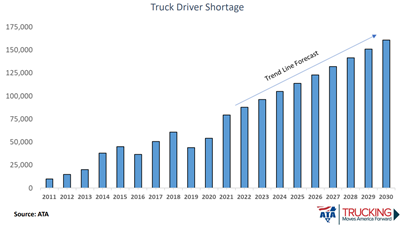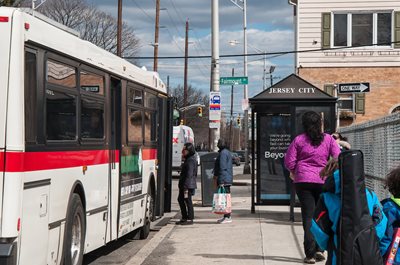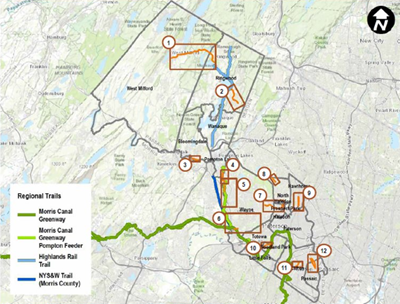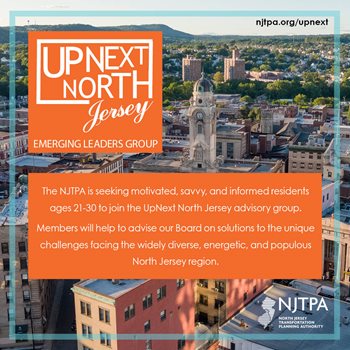June 2022
Posted: 6/28/2022 12:15:16 PM
The trucking industry is grappling with two challenges affecting many industries – supply chain issues and how to mitigate climate change.
These were the topics of the Trucking Industry Update at the NJTPA Freight Initiatives Committee’s June 21 meeting.
The truck driver shortage is expected to double from an estimated 80,000 last year to 160,000 by 2030, Nicholas Geale, Vice President of Workforce and Labor Policy at the
American Trucking Associations, said during his presentation.
Freight volumes have slowed from 2021 but remain elevated, according to Geale. While freight is transitioning back from the spot (one-time delivery) market to contracts, contract loads have struggled to fully return to pre-pandemic levels due to a lack of drivers and equipment, he said.
 The p
The pandemic years have been good for trucking generally, according to Geale, with lots of goods being transported, tight capacity and higher rates. Costs have been a challenge, however, when it comes to driver wages, retention and recruitment, liability insurance, equipment prices and availability, and spikes in fuel prices. Many fleets, especially smaller ones, could be in trouble in the next recession, Geale said, noting the potential for consolidation.
Constraints of supply and the lack of equipment and microchips are reaching the trucking industry just as any other. But he noted that the driver shortage is boosting wages.
“If you’re a truck driver, you’re probably the only person in America beating inflation the last three years,” Geale said, with 8.5 percent average annual increases since 2019 for long-haul truckers. “It will take a while to dig out of this supply hole, so driver pay will continue to increase.”
Drivers working fewer hours, due to federal hours of service requirements, and the average driver age reaching nearly 50, means the shortage will only get worse. Geale said the industry needs to work on attracting younger recruits and women, that later of which are only 7 percent of drivers.
“We need to do a better job of telling people about good jobs in the industry,” Geale said. “We can’t fill these jobs unless we make a long-term investment in our people and make it a job people want to be in because it’s a career and has long-term growth.”
In the short term, there are programs like the DRIVE Safe Act apprenticeship program and a task force that aims to increase the number of women in trucking. He emphasized making truck drivers a national in demand position for workforce training funds. In the longer term, Geale said it’s about expanding the poolto attract more women, former felons, young people, urban populations, and veterans among others.
A Look at Zero-Emission Trucks
- Internal combustion engine (ICE) powered by diesel
- Battery electric vehicle (BEV) powered by electricity
- Fuel cell electric vehicle (FCEV) powered by hydrogen
It examined production, energy production and consumption, and vehicle disposal and recycling for a Class 8 sleeper cab with a minimum range of 500 miles and vehicle life of one million miles.
The battery on a BEV was about six times more polluting than an ICE truck when it came to carbon dioxide because of the amount of mining and pollution involved in producing it. Production emissions for ICE trucks and FCEV were 75 percent and 84 percent less, respectively, according to the study.
.JPG.aspx?width=400&height=300) In terms of energy production and consumption, BEVs and FCEVs were comparable, and approximately 43 percent and 47 percent, respectively, less than the ICE vehicle emissions. The two also were lower in terms of life-cycle emissions by 30 percent and 46 percent, respectively. The two 17,000-pound lithium-ion batteries necessary for BEVs create some 20 times more emissions when it comes to disposal and recycling. Those batteries also impact BEVs in a lost revenue weight analysis versus ICE trucks.
The projected decrease in fuel production emissions for BEVs is more than 19 percent by 2030 and almost 34 percent by 2034. It’s “not as significant as you would think and not the panacea for decarbonizing the trucking industry,” Short said.
Both presentations and a recording of the meeting are available here.
In terms of energy production and consumption, BEVs and FCEVs were comparable, and approximately 43 percent and 47 percent, respectively, less than the ICE vehicle emissions. The two also were lower in terms of life-cycle emissions by 30 percent and 46 percent, respectively. The two 17,000-pound lithium-ion batteries necessary for BEVs create some 20 times more emissions when it comes to disposal and recycling. Those batteries also impact BEVs in a lost revenue weight analysis versus ICE trucks.
The projected decrease in fuel production emissions for BEVs is more than 19 percent by 2030 and almost 34 percent by 2034. It’s “not as significant as you would think and not the panacea for decarbonizing the trucking industry,” Short said.
Both presentations and a recording of the meeting are available here.
Posted: 6/22/2022 10:36:45 AM
The 2022 edition of the 16-page publication A Brief Guide to NJTPA Planning has been released. A flip-book is below and a pdf can be downloaded here.
Posted: 6/20/2022 3:53:21 PM
Jersey City “punches above its weight” when it comes to public transportation options, but a new study aims to address underserved areas within New Jersey’s second-largest city.
Elias Guseman, senior transportation planner for the Jersey City Division of City Planning presented findings from the JC on the Move study to the NJTPA’s Regional Transportation Advisory Committee (RTAC) during its June 13 meeting.
The study explored innovative and emerging transportation modes to address service gaps and expand the network. It was completed through the NJTPA’s Subregional Studies Program. The competitive grant program is open to the 13 counties and two cities on the NJTPA’s Board.
The study found that most trips were between the waterfront, Newport and Paulus Hook; Downtown to those three neighborhoods; and, between Journal Square and surrounding neighborhoods.
Transit service is oriented around peak periods and several major job and activity centers are difficult to access via walking, biking, and transit, according to the study. Traveling between certain places can take significantly longer on transit.
Some communities that are more reliant on transit have relatively poor access to it. Neighborhoods with significant levels of biking lack safe infrastructure and/or access to Citi Bike, the city’s bike share program, the study found. Citi Bike had the smallest drop in ridership among the transit options during the pandemic, down 12 percent in 2020 and 7 percent in 2021, compared with larger double-digit declines across the other modes.
 The study recommends expanding existing modes, such as Bus Rapid Transit (BRT), microtransit (like the City’s Via shuttle) and bike share. Various innovative modes and technologies were scored based on the best fit for Jersey City, the most feasible, and when they might become available. Scoring the highest were microtransit, BRT, and bike share, followed closely by autonomous vehicle (AV) shuttle, mobility hubs, and Mobility as a Service, which is a platform that would allow people to use various modes (NJ TRANSIT, PATH, Citi Bike, Via) through one payment and scheduling system.
The study recommends expanding existing modes, such as Bus Rapid Transit (BRT), microtransit (like the City’s Via shuttle) and bike share. Various innovative modes and technologies were scored based on the best fit for Jersey City, the most feasible, and when they might become available. Scoring the highest were microtransit, BRT, and bike share, followed closely by autonomous vehicle (AV) shuttle, mobility hubs, and Mobility as a Service, which is a platform that would allow people to use various modes (NJ TRANSIT, PATH, Citi Bike, Via) through one payment and scheduling system.
The study suggests implementing BRT along John F. Kennedy Boulevard, and reducing the number of stops on local service stops and further studying the best ways to streamline that service. The Via vehicle fleet could be increased to reduce wait times and improve on-time performance and expand service by extending Saturday and evening hours and adding Sunday. The study also suggests adding Citi Bike stations in The Heights, Greenville and the West Side.
The city could run its own pilot AV shuttle program, similar to what the City of Trenton is working on, in an area that lacks transportation options. or It could also work with jitney providers to upgrade and enhance services including transitioning to AVs and/or electric vehicles, improving customer communications, and integrating into a Mobility as a Service platform.
The study suggests establishing a working group of community stakeholders and partners to develop a vision and goals for the Mobility as a Service program. This would include data management groups to address integration of service provides into the same booking and payment platform. Guseman said the study identified several Mobility Hubs where this platform could be piloted, including:
- Journal Square
- Newport PATH station
- Garfield Avenue light rail station
- Danforth Avenue light rail station
- Kennedy Boulevard between Communipaw and Grant avenues
- West Side Avenue and Kensington Avenue, adjacent to Lincoln Park (existing Citi Bike dock)
- Bergen and Jewett avenues (existing City Bike dock)
- Central Avenue between Thorne and Congress streets and/or by Washington Park
The study is being finalized and will be posted to the JC on the Move study webpage in the coming weeks.
Posted: 6/16/2022 9:10:50 AM
Passaic County’s first bicycle master plan provides guidelines and standards on the types of facilities and detailed recommendations for a dozen locations that would create an expansive network of bike lanes spanning all 16 municipalities.
Andras Holzmann, supervising planner for the Passaic County Department of Planning, presented an overview of BIKE Passaic County to the NJTPA’s Regional Transportation Advisory Committee during its June 13 meeting. The study was completed through the NJTPA’s Subregional Studies Program, a competitive grant program open to the 13 counties and two cities on the NJTPA Board.
 With an area of nearly 200 square miles, Passaic County features a diverse geography, ranging from urban areas in the south, like the county seat of Paterson, its largest city, to rural areas in the north. The plan looked at areas that could connect to trails and future trails, such as the Morris Canal Greenway, Highlands Rail Trail, and NYS&W Trail in Morris County that briefly veers into Wayne, as well as to commercial corridors, downtowns and transit, according to Holzmann.
With an area of nearly 200 square miles, Passaic County features a diverse geography, ranging from urban areas in the south, like the county seat of Paterson, its largest city, to rural areas in the north. The plan looked at areas that could connect to trails and future trails, such as the Morris Canal Greenway, Highlands Rail Trail, and NYS&W Trail in Morris County that briefly veers into Wayne, as well as to commercial corridors, downtowns and transit, according to Holzmann.
The plan presents detailed recommendations, called concept level plans, for each of the following locations:
- West Milford Connection to Highlands Rail Trail, West Milford and Ringwood
- Ringwood Connection to Highlands Rail Trail, Ringwood
- Main Street Complete Street, Bloomingdale
- Morris Canal Greenway Connection, Wayne
- Black Oak Ridge Connections to Morris Canal Greenway, Wayne
- Parish Drive Connections to Morris Canal Greenway, Wayne
- Wayne-Haledon Community Connection, Wayne and Haledon
- High Mountain Road Connection to Nature Preserve, North Haledon
- Hawthorne North-South Connection, Hawthorne
- McBride Avenue, Woodland Park
- Clifton Avenue, Clifton
- Passaic-Clifton Community Connection, Passaic and Clifton
The plans include overviews of each location, maps, proposed improvements, and the level of difficulty to implement.
These preliminary concepts aim to build support for potential improvements and assist in developing funding and grant applications for design work and construction.
The study also resulted in the creation of a Pattern Book, which will serve as a design guide that includes standards for creating on- and off-road bike lanes, shared roads, pavement markings and more.
The master plan aims to increase safety and comfort, enhance access and mobility, inspire collaboration and coordination between government agencies and departments, and build community support for bicycling, and support economic, health, resiliency, and sustainability efforts.
The plan also makes planning and policy recommendations including:
- Establishing a bicycle/pedestrian or Complete Streets Advisory Committee with the responsibility of advising municipal staff and boards on bicycle projects and needs.
- Creating opportunities for people in Passaic County to borrow or purchase bikes, e-bikes, and tools at low or no cost.
- Engaging local groups to develop and implement an Open Streets event.
- Developing a plan for bicycle wayfinding signage.
 Holzmann said during the study some communities raised concerns about removing parking spaces to add bike lanes. The design guide presents some solutions, such as “hybrid streets,” which use a parallel network of bike lanes without impacting parking in tight urban areas, so if there are bike lanes in one direction on one street, they go in the other direction on another street. He said there are other potential options that could also be explored. “It’s something that we have to go into further detail about with those municipalities.”
Holzmann said during the study some communities raised concerns about removing parking spaces to add bike lanes. The design guide presents some solutions, such as “hybrid streets,” which use a parallel network of bike lanes without impacting parking in tight urban areas, so if there are bike lanes in one direction on one street, they go in the other direction on another street. He said there are other potential options that could also be explored. “It’s something that we have to go into further detail about with those municipalities.”
Once the final report is completed it will be shared on the study webpage.
Posted: 6/1/2022 11:26:41 AM
 The NJTPA is seeking young adults with ideas for how to improve transportation in the region and make northern and central New Jersey a vibrant place where people want to live.
The NJTPA is seeking young adults with ideas for how to improve transportation in the region and make northern and central New Jersey a vibrant place where people want to live.
The NJTPA launched the UpNext North Jersey young adult advisory group in partnership with Rutgers’ Public Outreach and Engagement Team in 2019 to get younger people more involved in the transportation planning process. The group is open to residents in the 13-county NJTPA region who are ages 21 to 30. The NJTPA aims to have about 25 active members and is seeking applicants to fill several vacancies. Applications are being accepted through June 30.
“The NJTPA’s work involves planning and preparing for the future, so it’s important that we engage younger people who will be using our transportation system for decades to come,” said Passaic County Commissioner John W. Bartlett, Chair of the NJTPA Board of Trustees. “The members of this advisory group have helped inform the Long Range Transportation Plan our Board adopted last year, and we look forward to getting their help on the Regional Active Transportation Plan project underway.”
Members of the UpNext North Jersey advisory group provide input on various NJTPA projects and programs, including regional efforts, like the Regional Active Transportation Plan, to smaller initiatives at the county or community level.
UpNext participants have ongoing opportunities to engage with thought-leaders and decision-makers throughout New Jersey. Events could include trips and site visits to unique locations around the region; participation in project-related activities; and opportunities to give back to their communities through volunteerism. The program aims to attract a broad range of young adults, not just those who are already engaged in planning or public policy fields.
“It’s important that we recruit young adults who are diverse as the region we represent,” said NJTPA Executive Director Mary D. Ameen. “We’re looking for people who want to help build the vision for the future of transportation in our region. Planning experience is not required.”
The NJTPA region includes Bergen, Essex, Hudson, Hunterdon, Middlesex, Monmouth, Morris, Ocean, Passaic, Somerset, Sussex, Union, and Warren counties.
Events are expected to take place quarterly and the NJTPA and Rutgers team will be looking to UpNext members to help plan and lead events, using the events as opportunities for participants to be both creative and hone their leadership skills as part of the process.
The application process is currently open. Those interested in joining should click here to apply. To learn more about the group, visit njtpa.org/UpNext.